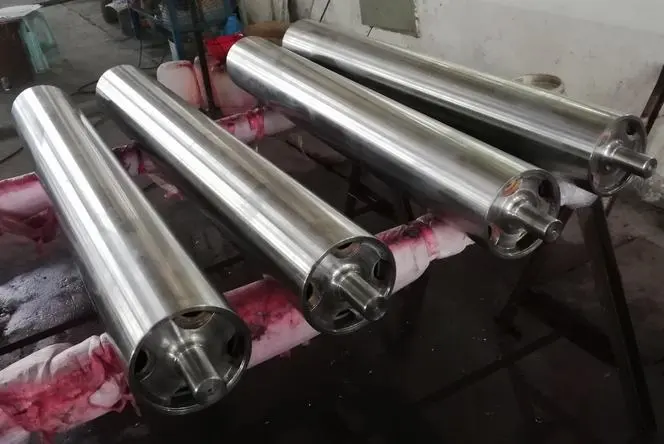Mechanical Property Testing for Stabilizer Rolls
Hardness Testing
Hardness testing is a fundamental aspect of assessing stabilizer roll performance. This evaluation typically involves methods such as Rockwell, Brinell, or Vickers hardness tests. These tests measure the material's resistance to indentation, providing crucial information about its durability and wear resistance. For stabilizer rolls used in demanding environments, such as oil and gas drilling operations, achieving the correct hardness is paramount to ensure longevity and reliability.
Tensile Strength Analysis
Tensile strength testing is another critical method used to evaluate stabilizer roll performance. This test involves subjecting a sample of the roll material to controlled tension until failure occurs. The results provide valuable data on the material's ultimate tensile strength, yield strength, and elongation properties. These parameters are essential for determining the roll's ability to withstand operational stresses and maintain structural integrity under various loading conditions.
Impact Resistance Evaluation
Impact resistance testing is crucial for assessing a stabilizer roll's ability to withstand sudden loads or impacts during operation. This evaluation typically involves Charpy or Izod impact tests, where a standardized pendulum hammer strikes a notched specimen of the roll material. The energy absorbed during the impact is measured, providing insights into the material's toughness and its capacity to resist fracture under dynamic loading conditions. This information is particularly valuable for stabilizer rolls used in applications prone to shock loads or vibrations.
Dimensional and Surface Quality Inspections
Precision Measurement Techniques
Accurate dimensional inspection is crucial for ensuring that stabilizer rolls meet the exact specifications required for their intended applications. Advanced measurement techniques, such as coordinate measuring machines (CMMs) and laser scanning systems, are employed to verify critical dimensions with high precision. These methods allow for the assessment of parameters such as diameter, length, roundness, and cylindricity. Ensuring dimensional accuracy is essential for proper fitment and optimal performance of the stabilizer roll within the larger mechanical system.
Surface Roughness Analysis
The surface quality of a stabilizer roll significantly impacts its performance and longevity. Surface roughness analysis is conducted using profilometers or optical measurement systems to quantify the microscopic irregularities on the roll's surface. This evaluation helps determine whether the surface finish meets the required specifications for factors such as friction, wear resistance, and fluid dynamics. A properly finished surface ensures smooth operation and minimizes wear on both the stabilizer roll and the components it interacts with.
Non-Destructive Testing (NDT) Methods
Non-destructive testing techniques play a vital role in assessing the internal quality and integrity of stabilizer rolls without causing damage. Common NDT methods include ultrasonic testing, magnetic particle inspection, and liquid penetrant testing. These techniques help detect internal defects, such as cracks, voids, or inclusions, that may not be visible on the surface. Identifying and addressing these hidden flaws is crucial for preventing potential failures during operation and ensuring the long-term reliability of the stabilizer roll.
Operational Performance and Durability Testing
Rotational Balance Evaluation
Proper rotational balance is critical for the smooth operation of stabilizer rolls, particularly in high-speed applications. Balance testing involves mounting the roll on a specialized balancing machine and rotating it at various speeds to measure any imbalance. This evaluation helps identify and correct any weight distribution issues that could lead to vibrations, increased wear, or reduced performance. Achieving optimal balance ensures that the stabilizer roll operates efficiently and minimizes stress on associated components.
Wear Resistance Testing
Wear resistance is a crucial factor in determining the longevity and performance of stabilizer rolls. Various wear testing methods, such as pin-on-disk tests or abrasive wheel tests, are employed to simulate the wear conditions the roll may encounter during operation. These tests provide valuable data on the material's resistance to abrasion, erosion, and other wear mechanisms. By understanding the wear characteristics, engineers can optimize material selection and surface treatments to enhance the durability of stabilizer rolls in specific applications.
Environmental Simulation Testing
Stabilizer rolls often operate in challenging environments, exposed to various temperature extremes, corrosive substances, or high-pressure conditions. Environmental simulation testing aims to assess the roll's performance and durability under these harsh conditions. This may involve subjecting the roll to temperature cycling, salt spray tests, or pressurized fluid exposure. These evaluations help verify that the stabilizer roll can maintain its integrity and functionality in the intended operational environment, ensuring reliability and safety in critical applications.
In conclusion, the comprehensive testing methods used to assess stabilizer roll performance are crucial for ensuring the reliability, efficiency, and safety of various industrial applications. From mechanical property evaluations to dimensional inspections and operational simulations, these tests provide valuable insights into the quality and capabilities of stabilizer rolls. By adhering to rigorous testing standards, manufacturers can deliver high-performance components that meet the demanding requirements of industries such as oil and gas, metallurgy, and mining machinery. For more information about stabilizer rolls and their testing methods, please contact us at info@welongpost.com.




